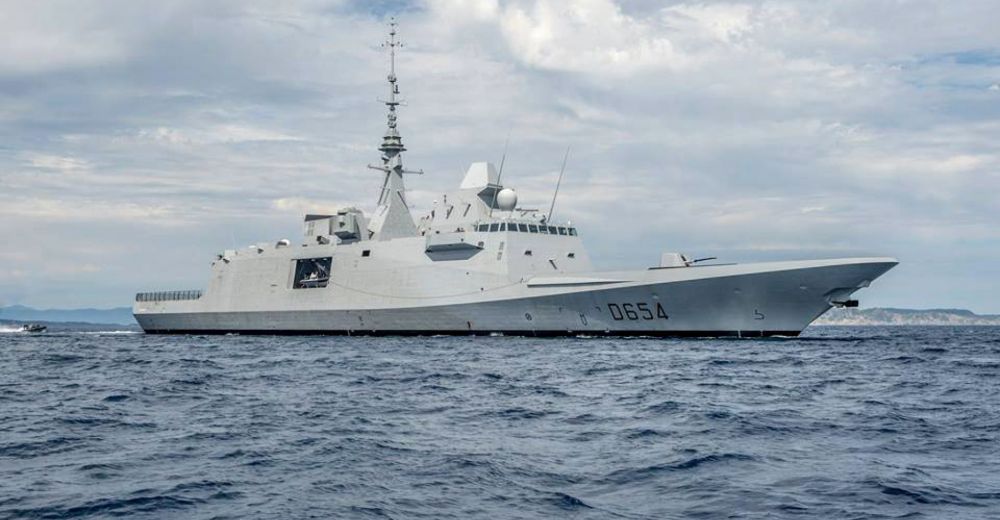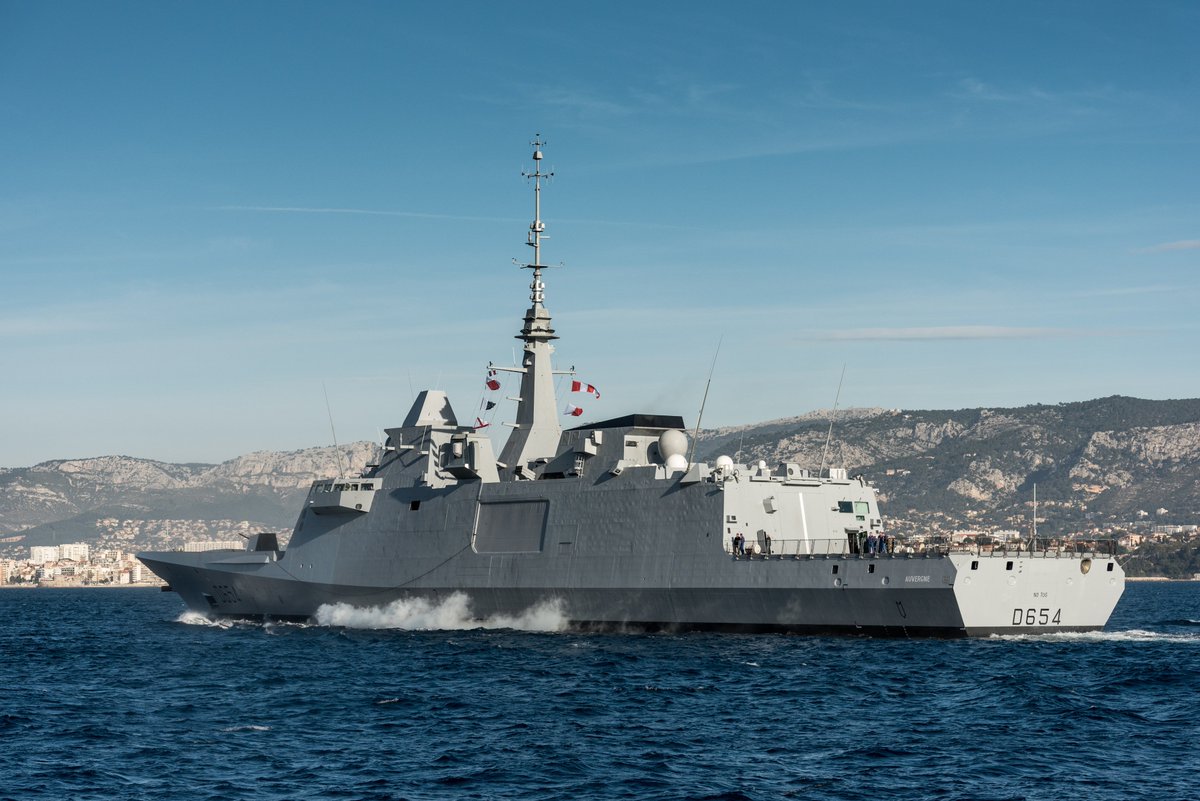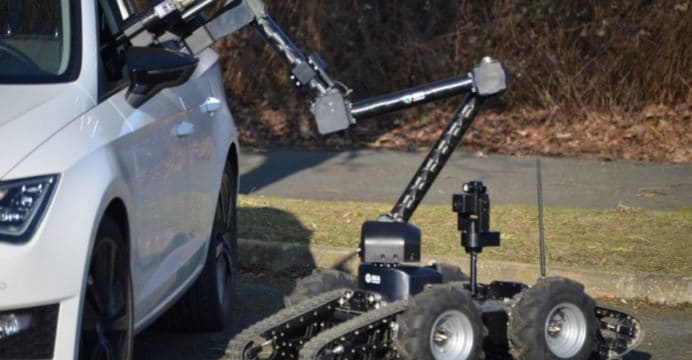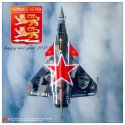You are using an out of date browser. It may not display this or other websites correctly.
You should upgrade or use an alternative browser.
You should upgrade or use an alternative browser.
France Military News, Reports, Data, etc.
- Thread starter navyreco
- Start date
Jura The idiot
General
I recalled her from Nov 5, 2017
French FREMM frigate Auvergne returned to Toulon December 21st from a sales trip to Australia and Asia

while nowooh la la

Le parcours inédit d'une frégate FREMM en mer de Chine méridionale
Translated from French by
The new course of a frigate FREMM in South China Sea
French FREMM frigate Auvergne returned to Toulon December 21st from a sales trip to Australia and Asia

Jura The idiot
General
timepass
Brigadier
AN OVER €30 M CONTRACT – ECA GROUP TO SUPPLY UNMANNED GROUND VEHICLES (UGVS) TO FRENCH MINISTRY OF ARMED FORCES

CEFA, ECA Group & SCOPEX were awarded a major contract for SMINEX tender released by French Defence Procurement Agency (DGA) for the technology qualification, supply & maintenance of complete EOD & C-IED Equipment Solution. This equipment is dedicated to search, detection, analysis & neutralization of IED (Improvised Explosives Devices) or UXO (UneXploded Ordnance).
The three partnering companies (see the press release) will supply the first evermade “road, rail & air deployable shelter of EOD & C-IED equipment” so as to provide transportation platform & in-service maintenance workshop for the 3 French Armed Forces (Army, Navy & Air Forces) – as a unique, interoperable solution to be qualified by the DGA (French Defence Procurement Agency).
SMINEX* is the first project relative to EOD equipment (individual protection suits, handheld detectors, X-Ray systems, water cannon, Unmanned Ground Vehicles (UGV), etc.) with a global approach in an integrated system to provide a maximum efficiency and resilience during operations.
Within the scope of this contract, ECA Group will supply the French Armed Forces with ground robots UGV IGUANA E and provide its expertise in integrated robotic systems to develop and qualify the mobile operations centers in shelters. This new solution will allow the operators to have a complete and modular integration of IGUANA E robot into a wide range of vehicles – so as to meet various and specific needs.
In the framework of this contract for a total amount of over 30 M€, ECA Group received a firm order over a timeframe of 40 months and an amount of over 10 M€ for the outcome of which is the delivery of 15 UGV IGUANA E robots equipped to neutralize Improvised Explosive Devices. Then, according to his needs and until 2024, the customer can through additional purchase orders up to an amount over 20 M€, be provided with up to 43 complementary UGV IGUANA robots and related equipment and maintain them in operational conditions.
The bomb disposal ground robot IGUANA E provides a complete solution in order to face any unconventional situation. This new generation UGV integrates a large set of equipment and performs complex operations (such as cars or false ceilings inspection, opening of packages, munition collect, etc.). Moreover, the UGV IGUANA E integrates intelligent solutions helping the operator to prepare his mission and reach his target in the most simple and ergonomic way. With its automatic mode the UGV IGUANA E is able cross obstacles independently and to intervene in places hard to reach. Thus, this robot can, for example enter and inspect marine vessels, climb autonomously stairs or intervene inside an overhead locker in the plane.
This contract is the first significant sale of the UGV IGUANA developed by ECA Group during 2015 and 2016. At the forefront of innovation, these latest developments for the French Armed Forces are part of ECA Group’s commitment to its customers and a proof of the reliability and efficiency of its solutions. These are designed for use in hostile, restrictive and demanding environments and ensure safe and precise operations with reliable and sustainable technologies.
In coming years, another set of significant tenders for this type of UGVs will be issued by several world’s armies. This contract awarded by French Defence Procurement Agency (DGA) is an important reference for ECA Group and its partners.
ECA Group
Recognized for its expertise in robotics, automation systems, simulation and industrial processes, the ECA Group has been developing complete, innovative technological solutions for complex missions in hostile and confined environments since 1936. Its product offering is designed for an international client base that is demanding, both in terms of safety and effectiveness. The Group’s main markets are in the defense, maritime, aeronautics, simulation, industrial and energy sectors. In 2016, the Group reported revenue of €112.5 million across its three divisions: Robotics & Integrated Systems, Aeronautics and Simulation.
The ECA Group is a Groupe Gorgé company.
The ECA Group is listed on Euronext Paris Compartment C. Indexes: SBF 250, CAC SMALL 90 and CAC IT- ISIN Code: FR0010099515 Ticker Code: ECASA – Bloomberg Code: ECASA:FP
IMPORTANT
This Press Release was requested for publishing by an external entity not associated with Quwa. Comments, opinions and discussions by external entities are not those of Quwa. Thus, Quwa does not accept responsibility or liability for the content of this Press Release. Quwa does not grant rights to reproduce or use this content. If your company would like to request Quwa to publish a press release, please .

CEFA, ECA Group & SCOPEX were awarded a major contract for SMINEX tender released by French Defence Procurement Agency (DGA) for the technology qualification, supply & maintenance of complete EOD & C-IED Equipment Solution. This equipment is dedicated to search, detection, analysis & neutralization of IED (Improvised Explosives Devices) or UXO (UneXploded Ordnance).
The three partnering companies (see the press release) will supply the first evermade “road, rail & air deployable shelter of EOD & C-IED equipment” so as to provide transportation platform & in-service maintenance workshop for the 3 French Armed Forces (Army, Navy & Air Forces) – as a unique, interoperable solution to be qualified by the DGA (French Defence Procurement Agency).
SMINEX* is the first project relative to EOD equipment (individual protection suits, handheld detectors, X-Ray systems, water cannon, Unmanned Ground Vehicles (UGV), etc.) with a global approach in an integrated system to provide a maximum efficiency and resilience during operations.
Within the scope of this contract, ECA Group will supply the French Armed Forces with ground robots UGV IGUANA E and provide its expertise in integrated robotic systems to develop and qualify the mobile operations centers in shelters. This new solution will allow the operators to have a complete and modular integration of IGUANA E robot into a wide range of vehicles – so as to meet various and specific needs.
In the framework of this contract for a total amount of over 30 M€, ECA Group received a firm order over a timeframe of 40 months and an amount of over 10 M€ for the outcome of which is the delivery of 15 UGV IGUANA E robots equipped to neutralize Improvised Explosive Devices. Then, according to his needs and until 2024, the customer can through additional purchase orders up to an amount over 20 M€, be provided with up to 43 complementary UGV IGUANA robots and related equipment and maintain them in operational conditions.
The bomb disposal ground robot IGUANA E provides a complete solution in order to face any unconventional situation. This new generation UGV integrates a large set of equipment and performs complex operations (such as cars or false ceilings inspection, opening of packages, munition collect, etc.). Moreover, the UGV IGUANA E integrates intelligent solutions helping the operator to prepare his mission and reach his target in the most simple and ergonomic way. With its automatic mode the UGV IGUANA E is able cross obstacles independently and to intervene in places hard to reach. Thus, this robot can, for example enter and inspect marine vessels, climb autonomously stairs or intervene inside an overhead locker in the plane.
This contract is the first significant sale of the UGV IGUANA developed by ECA Group during 2015 and 2016. At the forefront of innovation, these latest developments for the French Armed Forces are part of ECA Group’s commitment to its customers and a proof of the reliability and efficiency of its solutions. These are designed for use in hostile, restrictive and demanding environments and ensure safe and precise operations with reliable and sustainable technologies.
In coming years, another set of significant tenders for this type of UGVs will be issued by several world’s armies. This contract awarded by French Defence Procurement Agency (DGA) is an important reference for ECA Group and its partners.
ECA Group
Recognized for its expertise in robotics, automation systems, simulation and industrial processes, the ECA Group has been developing complete, innovative technological solutions for complex missions in hostile and confined environments since 1936. Its product offering is designed for an international client base that is demanding, both in terms of safety and effectiveness. The Group’s main markets are in the defense, maritime, aeronautics, simulation, industrial and energy sectors. In 2016, the Group reported revenue of €112.5 million across its three divisions: Robotics & Integrated Systems, Aeronautics and Simulation.
The ECA Group is a Groupe Gorgé company.
The ECA Group is listed on Euronext Paris Compartment C. Indexes: SBF 250, CAC SMALL 90 and CAC IT- ISIN Code: FR0010099515 Ticker Code: ECASA – Bloomberg Code: ECASA:FP
IMPORTANT
This Press Release was requested for publishing by an external entity not associated with Quwa. Comments, opinions and discussions by external entities are not those of Quwa. Thus, Quwa does not accept responsibility or liability for the content of this Press Release. Quwa does not grant rights to reproduce or use this content. If your company would like to request Quwa to publish a press release, please .
TerraN_EmpirE
Tyrant King
Dassault details Rafale order backlog
- 11 JANUARY, 2018
- SOURCE: FLIGHTGLOBAL.COM
- BY: CRAIG HOYLE
- LONDON
Dassault ended last year with a firm order backlog for 101 Rafales, after delivering nine of the type during 2017.
In a financial overview released on 8 January, the airframer says it shipped eight Rafales to Egypt and a single example to the French air force last year, in line with its planning expectations. Additionally, it returned one Rafale M for service with the French navy, after upgrading it to the latest F3 operating standard.
Dassault says its firm order backlog for the multirole combat aircraft stood at 101 units as of 31 December 2017. This includes 31 to be produced for its domestic operators, plus 70 for export customers. In addition to Egypt, which has so far fielded 14 aircraft from an eventual total of 24, other international buyers include India (24) and Qatar (36).

Dassault
The 101-strong backlog figure represents a reduction of nine units since the same point 12 months earlier.
Jura The idiot
General
here's according to DefenseNews What we’re learning about France’s air special forces as they publicly recruit
source:The French Air Force is for the first time promoting its special forces unit in a bid to recruit civilians as an addition to the existing 750 personnel assigned to the Special Operations Command.
The service previously recruited solely from the military but is now looking to diversify the talent pool with a mix of experienced and young unskilled recruits from the civilian world, Air Force Gen. Louis Fontant said Jan. 11 during a weekly briefing at the Armed Forces Ministry.
That recruitment stands in stark contrast to a previous policy that forbade any communication about the special forces, which draw on the Air Force, Army and Navy for personnel and equipment.
“Before, there was strict confidentiality about special operations, so the special forces were not allowed to talk about themselves,” he said. The recruitment problem lay in “not communicating. Now we have to do it.”
How many positions are available?
The service is looking to recruit some 40 personnel for general duty before training them for specialist roles such as sniper, transmission specialist or translator. France has produced a high-production video to promote the Air Force special forces.
The small number of 40 is so the special forces unit can make “as small a footprint” as possible in operations, Fontant said. There is “financially considerable” backing, as equipment is made readily available, he added.
The service seeks a highly diversified yet coherent unit, capable of operating quickly, at long distance and with fire power, he said. Regarding the latter, a special forces team of up to 10 can call in an airstrike from a Rafale fighter jet.
The core of the air special forces comprises 640 personnel assigned to commando paratroopers, air transport and helicopters. These units engage in at least one operation per year and draw on support from specialists in the conventional forces.
The Orleans air base, central France, supports Commando Parachute Group No. 10 and 3/61 Poitou Transport Squadron.
France would like to see a 280-strong commando unit, but actual staffing is at 250, which is why the service is actively recruiting.
What are their responsibilities and capabilities?
The commandos detect targets, gather intelligence and transmit to friendly forces. They designate targets and assess damage following airstrikes.
There is a team dedicated to inspecting a landing area and checking the ground for parachute drops and special forces landings. The base trains for missions including sabotage, destruction, intelligence gathering and recovery of personnel.
The 3/61 Poitou Transport Squadron flies C-160 and . These tactical transports can drop paratroopers at low, medium and high altitude, with commandos wearing oxygen kits as they jump at more than 4,000 meters. The aircraft also serve as flying command posts and radio relay stations. The DHC-6 light planes fly dangerous logistics drops and fly out the wounded.
The 1/67 Helicopter Squadron at Cazaux Air Base, southwestern France, formally received full operational capability for special forces in December. The Caracal helicopters can be refueled midair, a capability highly valued for current missions, according to Fontant.
Beyond the core special forces units, the service draws on some 100 in support teams from conventional forces.
Support units include a team to detect arms and drugs, while a command and control team based at the Evreux air base, northern France, sends specialists to deploy long-distance communications. Those links allow special forces to talk to the command post and fighter jets.
There are also loadmasters to check cargoes and paratroopers as they jump, often at night and at low altitude.
In other support, there is a fire brigade unit that handles nuclear, bacterial and chemical threats, as well as a group of Army personnel that builds deployed air bases.
The Normandie-Niemen 2/30 fighter squadron at Mont-de-Marsan Air Base, southwest France, provides reconnaissance, fire support and airstrikes.
Another support unit is the Belfort squadron, which flies six General Atomics Reaper UAVs. These drones have electro-optical sensors and are “absolutely indispensable” for the special forces in the Sahel region, Fontant said.
The Reapers are due to be fitted soon for electronic intelligence missions, and they will eventually be armed, according to the Armed Forces Ministry. The latter capability would “shorten the loop” between observation and attacking a target, Fontant noted.
What are the drawbacks?
Fontant took up the post of commander of the Air Force special forces in September, a position created in response to France’s rising in recent years.
The Air Force is seen as key to France operating over vast distances in the the sub-Saharan Sahel theater, allowing the military to avoid land-based ambushes and mines. Travel by air also provides an element of surprise.
The service delivers firepower with its combat aircraft, backing up special forces that are deployed in small numbers and have limited firepower.
There is “excellent availability” of 90 percent for transport aircraft deployed, helped by maintenance staff assigned to the special forces, he said. There is, however, generally low availability in France of an aging fleet of C-160 Transall aircraft. The Air Force has had to extend its service life, which requires high maintenance.
The special forces are also dealing with poor servicing of C-130 Hercules airlifters.
“We are confronted ... essentially with an industrial problem,” Fontant said. “Perhaps the change of the service company will solve the problem.”
Ogma, a Portuguese company, provides service for the C-130.
“In any case, we hope the gradual entry into service of the A400M over the next few years will resolve the logistical problem for conventional and special forces,” he said.
The Airbus A400M fleet by the French Air Force has an availability of 40 percent, a source close to the program said. Maintenance, including checks on an interim fix on the propeller gearbox on the engines, pull some A400M out of service, while others are undergoing a retrofit. Of the 13 A400M delivered to date, five are flying.
A heavy vehicle ordered for the special vehicles “is not satisactory,” Fontant said. “That is where we are. It is up to the joint chief of staff and DGA [Direction Générale de l’Armement procurement office] to decide.”
Renault Trucks Defense adapted its Sherpa Light for the VLFS heavy vehicle for the special forces, but that unit has so far failed its certification.










